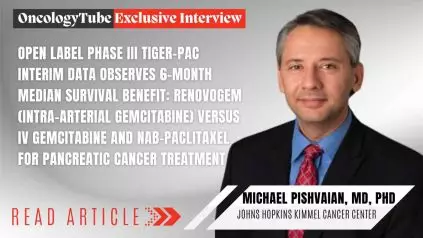Open Label Phase III TIGeR-PaC Interim Data Observes 6-Month Median Survival Benefit: RenovoGem (Intra-Arterial Gemcitabine) Versus IV Gemcitabine and nab-paclitaxel for Pancreatic Cancer Treatment
By Michael Pishvaian, MD, PhD
Locally advanced pancreatic cancer has its own challenges because we’re really focused on trying to treat the tumor where it lies within the pancreas, while also treating the systemic micro metastatic disease that almost certainly is there. It’s also not usually a situation where we’re trying to get the patient to the point of operability. Unfortunately, we know that at least 85% of patients with locally advanced, unresectable pancreatic cancer, as defined by classical NCCN definitions, will never get to the point of operability. So really, it’s about local control and systemic control. We traditionally will start with chemotherapy because as we’re learning with most stages of pancreatic cancer, it’s really the systemic disease that causes the most problems. And with the two therapies that we have available to us, Gemcitabine and nab-Paclitaxel and FOLFIRINOX, we do actually have a pretty good success rate in achieving some level of systemic control. But the question really becomes, after you’ve had a period of systemic control, are there things that you can do to the primary tumor, whether it’s radiation therapy or other techniques to try and control the primary tumor as well? And of course, most importantly, if you do that, will it actually change the outcomes? To date, we’ve never actually had any proof that adding a local control modality will improve the outcome for these patients. In fact, actually we’ve had several studies that have shown us that giving radiation therapy in conjunction with or sequenced with systemic therapy does not improve overall survival.
Watch and Share the Video Here: https://oncologytube.com/v/41893
What are your thoughts on the TIGeR-PaC study’s interim analysis results?
The results of the TIGeR-PaC study are definitely very intriguing. It is an interim analysis so we always have to take those with a grain of salt, but at the same time, an improvement of 6 months in overall survival is fairly remarkable for this stage of disease and with where these patients are in their cancer journey. And I’m glad that the focus was really on meeting overall survival because when we’re talking about a study that’s assessing a local modality. Then the ultimate question is, “Is it helping improve overall survival?,” because as I mentioned, things like radiation therapy, which is also a local therapy, has unfortunately not been shown to improve overall survival. So if local therapy with RenovoGem, intra-arterial therapy platform of gemcitabine, is going to improve overall survival, that’s actually a meaningful change for these patients. Of course, we have to wait for the final results to see if that actually pans out.
If the RenovoGem study continues on this positive trend and meets its endpoints. How important will this data be to the oncology community?
If the data continues with this same trend and the final overall survival analysis does show a significant improvement in overall survival, then for a disease and a stage of disease where there really haven’t been any major changes since the implementation of the FOLFIRINOX, and Gemcitabine and nab-Paclitaxel now 12 years ago. This could be something that would be potentially practice changing. It would be a challenge to figure out how we’re going to incorporate this in routine practice because it is a juxtaposition and interaction between the medical oncologist and the interventional radiologist. In many centers there is a growing group of interventional oncologists who are really focused on treating the cancer through different interventional radiology, different techniques that they have available to them. And I would definitely try and work with my interventional oncologist that we have here to maximize the timing and the schedule and the sequence to start to incorporate this kind of therapy for our patients with locally advanced unresectable pancreatic cancer.
Michael Pishvaian, MD, PhD – About the Author, Credentials, and Affiliations
Michael Pishvaian, MD: A Renowned Oncologist and Researcher in Precision Medicine for Pancreatic and Colorectal Cancer Treatment
Dr. Pishvaian is an Associate Professor at the NCR Kimmel Cancer Center at Sibley Memorial Hospital and Director of the Gastrointestinal, Developmental Therapeutics, and Clinical Research Programs at the Johns Hopkins University School of Medicine. Prior to his current position, he held a similar role at the University of Texas, MD Anderson Cancer Center, where he was also Co-director for Clinical Research at the Sheikh Ahmed Bin Zayed Al Nahyan Center for Pancreatic Cancer Research. Dr. Pishvaian earned his MD and PhD in Tumor Biology from Georgetown in 2001, where he also completed his medical residency and fellowship in Hematology/Oncology. His research focuses on precision medicine for patients with pancreatic and refractory colorectal cancer, with a particular emphasis on targeted therapy for homologous recombination DNA repair deficient tumors. Dr. Pishvaian is also a co-investigator on an NIH RO1 studying resistance mechanisms to PARP inhibitor-based therapy.

